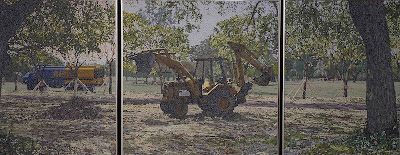By Emma Trelles
BOCA RATON — There are usually unexpected prizes hidden in the auditorium gallery of the Boca Raton Museum of Art, where an intimate flourish of paintings can pay tribute to women artists of the 20th century or to the grapple between morphing American culture and the modernist artists who tried to frame it.
At times these little shows can be overlooked. The Wolgin Auditorium is tucked behind the gift shop on the first floor, unseen to visitors fast-stepping it towards the larger fare unfolding across the grand hall and the galleries beyond. That’s too bad, because senior curator Wendy Blazier does a fine job at combing through the museum’s permanent collections and offering a freshly presented bite of contemporary art.
With David Maxwell: To the Point, Blazier has once more proven that bigger is not necessarily better, although it must be said that Maxwell’s technique is large in its ambitions and his subject matter unarguably brawny. The 15 paintings here are culled from museum holdings, private collectors, and Maxwell’s estate, and all of them employ his signature, neo-pointillist brushwork and a decades-long gaze at South Florida’s cityscapes.
The paintings are surprisingly lyrical in their portrayal of condominium and office towers, concrete mixers and dumpsters, or cranes dredging dirt to make way for more sprawl. Especially beautiful are Maxwell’s evening vistas, impressionistic studies of light — except the late painter is concerned with electricity and glassy reflection instead of the soft, bucolic stretches of lawns and lakes found in the work of one of his chief influences, Georges Seurat.
Like the 19th century neo-impressionist, Maxwell, who died in 2006, was also drawn to urban vignettes, so his subject matter for these night pictures include the neon-lit cafes that fringe Hollywood’s Young Circle or the Trump Plaza in West Palm Beach.
The latter portrait hardly sounds inspiring, but the artist elevates it through his meticulous attention to form. The 35-story waterfront high-rise, as with all of Maxwell’s studies, is fashioned with a network of precisely placed dots, which also drizzle color and geometry across the nearby bay and transform the lamps arcing a bridge into pulsing ghosts. Such is Maxwell’s attention to paint — he did not simply dot the canvas but filled in each minuscule circle with opaque watercolor — that the picture resembles an embroidered panel of velvet from a few steps away.
An autodidact, Maxwell worked for nearly 30 years in building and concrete construction, and he was no stranger to the toil needed to make a thing. His method was devout. Besides carefully drawn and colored dots, Maxwell studiously photographed his subjects, then hand-gridded their images to the canvas, one of which could take up to a year to complete.
He has been compared to Chuck Close — Robert Bechtle and Robert Cottingham also come to mind – but Maxwell’s visual intent was rarely literal: the hundreds of snapshots he took for his paintings were further parsed into his own final invention. A hulking metal digger at Hollywood’s Topeekeegee Yugnee Park, titled T.Y. Saurus, is centered amidst a strand of live oaks, but these trees might have well been photographed throughout the park and later added around the equipment, giving it, as well as the rest of his beloved pavers and wheel scrapers, the look of holy objects, mechanized and hard-gleaming.
The suite of construction paintings further show how place permeated Maxwell’s art. Born in Chicago, he lived and worked much of his life in a Miramar duplex he shared with his wife Mary. As much as he paid attention to his built-in environs, Maxwell also had a sharp eye for Floridian detail: his skies are spot-on and appear as they do in late summer, flat blue and unmarred by clouds. Against it, his cranes and bridges emerge as delicate instruments, vital to the people who use them for reinventing their towns.
Development can be dispiriting, but it can also hold giddy anticipation. At exhibit’s end, a letter from Maxwell to a collector discusses his painting of the museum’s groundbreaking in 2002. “I just finished my piece of the Boca Museum (celebrating the construction process) during its beginning phases…it is a portrait of an overloaded dumpster and an assemblage of colorful equipment with a few block walls being laid from a lot of scaffolding. They were very excited about showing it off…”
Emma Trelles is an arts and culture writer in South Florida.
DAVID MAXWELL: TO THE POINT is on display through Sunday, July 19, at the Boca Raton Museum of Art in Mizner Park. Admission: $8 adults, $6 seniors, for regular exhibits. Hours: 10 am-5 pm Wednesday, Thursday, Friday; 12 pm-5 pm Saturday-Sunday. Closed Mondays, Tuesdays and holidays. Call 392-2500, or visit www.bocamuseum.org for more information.


